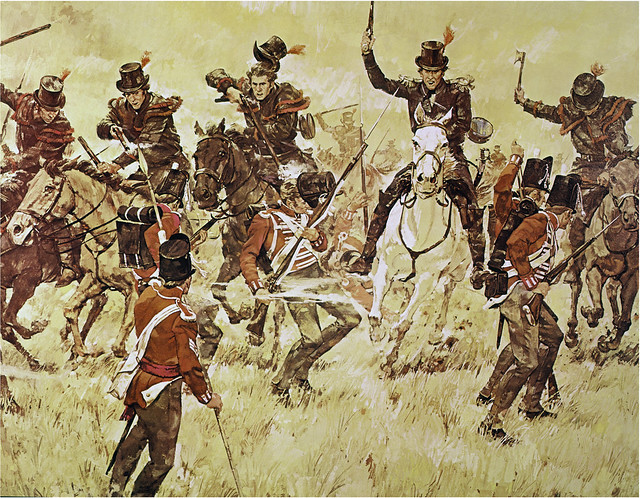Kentucky Mounted riflemen at the Battle of the Thames, 1813. US Rangers were most likely armed and equipped similar to these volunteer units.
The famed light infantry/ scouts of the modern United States Army, the Rangers, trace their origins back to Roger's Rangers, a company of colonial scouts that served during the French and Indian War. During the American Revolution (which some might call the first American Civil War), Major Rogers and many of his rangers served on the British side. Ranger units were also organized in the Continental Army, and more came into being during the American Civil War. The modern units date back to 1942 when George C. Marshall authorized a unit of commandos similar to the British SAS.
A far less-known organization of US Army rangers was established during the War of 1812, by an Act of Congress on January 2nd, 1812. 6 companies were authorized for one years' service. Shortly after their enlistments expired, another 10 were authorized. Shortly after the war ended in 1815 they were disbanded.
The original Act which established ranger companies, to "serve on foot, or mounted."'
Another Act the following year that exchanged one 10-company regiment of infantry for 10 companies of rangers. Not a bad trade, considering many regular infantry regiments existed only on paper or badly understrength.
Two Boons and a Boone served as officers in these ranger companies. Nathan and Daniel Morgan Boone were the sons of Daniel Boone, the famous frontiersman.
How did the rangers serve? I have encountered references to independent companies of United States Rangers. Although organized as regular army, these units fought individually for the most part, patrolling, raiding, and protecting the vast spaces of the trans-Mississippi frontier. At least one ranger unit served as a garrison in the occupied part of Western Canada after 1813. A letter of 3rd Lieutenant James C. Pickett, 2nd Regiment US Artillery, stationed at Fort Detroit in 1814 mentions that 20 artillerymen and a lieutenant had been sent to garrison Fort Malden, in Amherstburg, Ontario. "A very few" rangers were the remainder of the garrison.
In practice, most regular Ranger units were probably mounted: Gregory J. W. Urwin's history of the US Cavalry mentions them most often in the context of raids against Indian villages. According to his book, the Rangers were "part regulars and part woodsmen... supposed to patrol between the blockhouses erected by the state and territorial governors, and cooperate with the local militia in punitive strikes against marauding bands." (Urwin, 40).
Although specific references to how the Rangers were equipped and dressed are elusive, they were most probably uniformed in hunting frocks similar to those worn by the Regiment of Rifles, militia, and mounted riflemen. From their activities and description, it seems safe to assume that they were trained to fight as mounted riflemen, maneuvering on horseback and dismounting to fight in open order.
As far as similarities to the modern Army Rangers go, perhaps the closer antecedent to their unit were the United States Rifle Regiments, infantrymen trained to fight in open order with rifles, and often used in commando operations and raids. Both the Rangers and the Riflemen were the successors to Robert Rogers' techniques of Indian warfare.

No comments:
Post a Comment
Note: Only a member of this blog may post a comment.